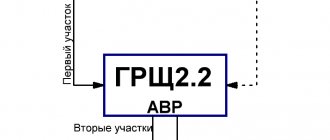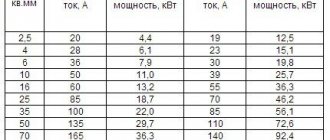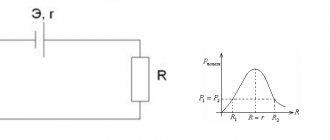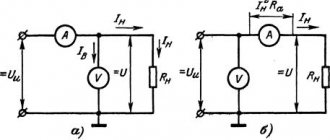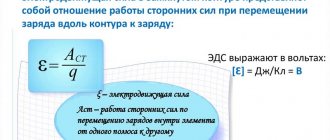What is “dedicated power” of electricity?
The allocated power is the maximum permissible load on the consumer's network.
The permitted energy power in the apartment is the maximum value that the consumer can use at a time. The maximum load on the consumer network is always specified in the electricity supply contract.
To fully understand the issue of permissible power, it is worth understanding its types. Today there is power:
- connected - the sum of the power indicators of all electrical equipment connected to the network;
- installed - indicated in the documentation for the equipment and provides for the functioning of the devices in normal mode;
- one-time - determined based on calculations of the power consumption of devices for a specific period of time;
- temporary or permitted - the maximum indicator that the energy supply company provides to the user.
The regulation of relations between electricity providers and consumers was approved by the Ministry of Energy of the Russian Federation on January 19, 2002.
What is allocated power
In Soviet times, in most residential buildings, from the moment of design, the norm was 1.5 kW per apartment. These houses are still in use today, but there is not enough power. Later the norm was increased to 3 kW as consumption increased.
Today, 10-16 Ampere plugs are installed in meters, thus limiting the current per apartment to 3 kW. If there is no gas stove, but an electric stove is used, 7 kW is allocated to the apartment.
Modern new buildings emit up to 15 kW. It is worth keeping in mind that in order to meet the limit, you need to enter three phases at once; you may not be able to meet the limit on one phase. Especially if you have to connect an electric stove. As a rule, the allocated power is increased in non-residential premises and in industries, where, indeed, a lot of electricity is consumed.
Let's give a simple example. If a country house is to be heated with an electric or solid fuel boiler, then per 100 m2 you will need a device with a power of up to 10 kW; when using an electric stove, add another 5 kW. The minimum required power is 15 kW for houses and three phases.
To know exactly what the allocated power is in your apartment or house, you need to contact the operating organization (Lenenergo, St. Petersburg Sales Company, Petroelectrosbyt) and obtain the appropriate certificate. It specifies the allocated power and the average value of electricity consumed.
What are the dangers of exceeding the permitted power?
Example of a consumer notification
Based on Russian Government Decree No. 624, if the maximum load is exceeded, the electric company has the right to limit the consumer’s access to the power grid. The reason is non-compliance with obligations under the electricity supply contract.
In case of accidents or during work on the power line, Energosbyt employees take measurements. In cases where inaccuracies are identified, they send notifications. The user must take measures to eliminate excess power within 10 days. The degree of his responsibility is determined by the violation:
- ignoring the notification after 10 days – turning off the power supply to the facility;
- connection bypassing the line - charging a fine, recalculating the power according to the maximum indicator from the moment of inspection, connecting to the public network at the expense of the violator;
- non-contractual use – fine for lack of agreement, recalculation based on normal power indicator.
The basis for termination of sanctions is documentary evidence of the adoption of measures. However, UOMPE, CCD and PZR devices are installed on the user line.
The act of non-registration is drawn up in the presence of 2 witnesses, with photos and video recording of the process.
Rules and regulations
Seal on the input machine
Electrification of residential, administrative, and industrial facilities is carried out on the basis of the technical specifications of the provider organization. One of the clauses of the contract specifies how much power will be allocated to the consumer network. The basis for declaring power and forming technical specifications are calculations.
Electrical connection to residential and public buildings is carried out in accordance with SP 31-110-2003 and temporary instructions RM 2696-01. The documents state that the allocated electrical power for houses that consume electricity of the 1st category is not standardized. Objects are connected based on requests.
Housing stock of the 2nd category has two electrification standards:
- from 5 to 7 kilowatts is the norm for a private house or apartment where gas stoves are installed;
- from 8 to 11 kW - for objects where there is an electric stove.
The least amount of power falls on a small-sized apartment and a house built under the social housing program.
Currently, the standards from 2006 are in effect. In buildings before this period, the power output is much lower.
How to find out how much power is allocated
Operating current parameters
You can find out reliably how many kilowatts there are per apartment with a gas or electric stove in this way:
- Contact your energy provider for help. The service is paid, depending on the region. A certificate from Mosenergosbyt, for example, depending on the type of object, costs 1.3-3.1 thousand rubles.
- Find the data in the electricity supply contract or technical specifications.
Independent calculations are made based on the parameters of the input protection device. The user needs to know the operating current and then perform mathematical calculations. For example, the operating current indicator is 32 A. To calculate the maximum load limit, the formula is used: P max = U x I nom x 0.8; where U is the rated network voltage. That is, 230 x 32 x 0.8 ≈ 5.5 kW.
Calculations based on meter readings are not always correct due to the built-in load relay.
Connected power of consumers
Connected power of consumers is the value of the total power of the subscriber's transformers, which convert electrical energy into the operating voltage of the subscriber's electrical receivers (consumers) and electric motors with voltages over 1000 V, connected directly to the electrical network of the energy supplying organization. If the electrical installations of subscribers (consumers) are powered by transformers or networks of the energy supplying organization with a voltage of up to 1000 W, the connected power of the consumers is taken to be the power allowed by the contract for consumption, the size of which is established by the energy supplying organization.
Connected contractual electric power is the maximum amount of total power consumed by the subscriber established by the contract, depending on the time of day, day of the week, month, season and power supply mode. The energy supplying organization transfers this power to the subscriber (consumer) subject to the latter's compliance with all technical requirements, including the technical and operational characteristics of electrical buses connecting to their networks. In modern In the system of economic relations for the production and sale of electricity, commercial operating organizations arose, to which, in accordance with current legislation, the rights of trust management of the electrical network were transferred to them by the owner of the energy system. Their functions also include concluding agreements on the amount of connected power of purchased energy.
In the energy purchase and sale system, the law allows the so-called “consumer-regulator” (legal entity), which undertakes in the contract the obligation to participate in the agreed amounts in regulating the schedule for using the consumer’s connected power. Basic a consumer-subscriber who buys connected electrical power, both for his own consumption and for partial sale to subscribers connected to his networks, in relation to which he acts as an energy supply organization. The division of the Unified Energy System into many owners provided for by the reform, each of which can enter into agreements on the connection and distribution of electrical capacity, is the objective reason for the significant increase in tariffs for the final product of electricity production - electricity.
Source:
Encyclopedia of statistical terms. — M.: Federal State Statistics Service, 2013.
Calculation of required power
Calculations are made if it is necessary to determine whether the allocated volume is sufficient. The maximum load is calculated as the sum of all devices turned on at the same time. If the registration certificate is lost or the sticker on the equipment is worn out, you should refer to the data in the table.
| Consumers | Power, W |
| Appliances | |
| Electric stove | 1100-6000 |
| Hairdryer | 450-2000 |
| Iron | 600-2000 |
| Heater | 1000-2400 |
| Vacuum cleaner | 400-2000 |
| TV | 100-400 |
| Washing machine | 1000-3000 |
| Fridge | 150-2000 |
| Computer | 400-750 |
| Kettle | 1000-3000 |
| Fan | 750-1700 |
| Tools | |
| Hammer | 600-1400 |
| Drill | 400-800 |
| Circular Saw | 750-1600 |
| Hay mower | 750-2500 |
| Jigsaw | 250-700 |
| Circulating saw | 1800-2100 |
| Sander | 650-2200 |
| Household equipment | |
| Compressor | 750-2800 |
| Water pump | 500-900 |
| Air conditioner | 1000-3000 |
| Fan | 750-1700 |
| A gas boiler | 40-1000 |
| Electric boiler control | 1000 |
Having calculated the amount of consumption, you need to indicate a reserve when the load increases. The devices will consume 20-30% more than the calculated value. The sum of the two indicators is the final result. If the estimated power is lower than declared, you can apply for an additional 1-3 kW.
How to find out the maximum power of a car
In the vehicle registration certificate this value is written in kW. At the same time, motorists can independently convert the value into horsepower. In this situation, the exact kW figure is multiplied by a factor of 1.35. If it is necessary to do the reverse calculation, then the total hp. multiplied by 0.735. As a rule, the vehicle documentation provides accurate data. However, if a car owner has certain doubts, he can contact a special service center, where diagnostics and measurement of the vehicle’s power are carried out.
How many kilowatts can the wiring in the apartment withstand?
Table of cable power depending on the cross-section
Under ideal conditions, a standard copper conductor with a cross-section of 2.5 mm2 can withstand a load of 5.9 kW, and an aluminum conductor - 4.4 kW.
Under operating conditions, aluminum conductors of old houses with a cross-section of 2.5 mm2 can withstand 3.5 kW at a current of 16 A. APPVs of 6 mm2 do not burn out at a load of 5.5 kW and a current of 25 A. Wires with a cross-section of 4 mm2 will withstand 4, 4 kW at current 25 A.
According to the rules of the PUE, a three-core copper wire with a cross-section of 1.5 mm2 must withstand a maximum permissible load of 5.9 kW. 4 mm2 cable – 8.3 kW with a current of 28 A. Conductor with a cross-section of 6 mm2 with a current of 46 A – 10.1 kW.
The new generation KIA Cerato has not yet been declassified, but the start date of sales in Russia has already been announced
Kia
It's worth noting that the efficiency of any vehicle mainly depends on the current horsepower ratio as well as the overall weight of the vehicle. In other words, cars with more horsepower are not simply considered more powerful and can demonstrate better dynamics. Also based on this, it turns out that increasing the number of horsepower and reducing the weight of the car allows you to increase the dynamics and acceleration speed up to a certain point. As for increasing the weight of the machine, in this case more power will be required to achieve the set result in the same period of time.
How to increase allocated power
The power of electricity in an apartment or private house can be increased based on new technical conditions. The document is valid for 2 years. It states:
- new permitted power indicators;
- voltage parameters – 380 or 220 V;
- environmental standards;
- ways to control the consumption and conservation of electricity.
Features of treatment for individuals and legal organizations vary.
For individuals
Fragment of a standard act of delimitation of book value
Additional capacity must be installed in stages:
- Collection of documents - a certificate or agreement on real estate ownership, a certificate with current power parameters, an agreement with an energy supplier, an act of shared operational responsibility.
- Implementation of a building electrification scheme.
- Agreeing with the provider company on the possibility of increasing power.
- Signing of the project at Energonadzor.
- Inspection – The power plant is inspected and tested.
- Drawing up a report and approval for increasing the power load. The first document is prepared by an employee of the energy company, the second by a representative of Energonadzor.
All documents are sent to the supplier company, which makes the final decision.
For legal entities and companies
The sequence of the procedure is similar to the algorithm for private users. Only the documents differ. An ordinary citizen presents a passport, and a legal entity presents constituent papers. They are certified with a wet round seal and the signature of an authorized person.
If the technical connection papers do not contain information about the maximum power parameters or they were lost, the network enterprise has the right to re-register. It is implemented on the basis of a consumer application in the form established by the organization. The electricity supplier, according to Regulation No. 861, should not expand the list of documents and request additional data.
How to increase maximum power
It is necessary to take into account the fact that the maximum power of the car is not the final indicator, and if necessary, it can be significantly increased. To do this, you can resort to the following methods:
- increase in internal combustion engine volume;
- improvement of the intake system;
- car chip tuning;
- installation of a more powerful turbocharger.
Also, if necessary, you can increase power, although not so significantly, by installing a lightweight flywheel or by reducing the friction of the piston on the cylinder walls using special additives.
Volume increase
The most effective ways to increase engine performance are to chip the car, install a larger internal combustion engine, as well as upgrading the intake or increasing the boost pressure. In the situation with volume, everything is quite simple, since a unit with a large displacement is capable of delivering significantly more horsepower if we are talking about a standard naturally aspirated engine. Of course, in this situation it is not at all necessary to change the installation, since you can speed up the engine and thereby significantly improve its performance without significantly changing the volume.
Intake upgrade
Such modifications are carried out when the car undergoes global modernization. If we talk about a separate improvement in the intake, then the increase here will not be so significant. As a rule, for a better effect, the standard air filter is eliminated here and a zero one is installed in its place. The throttle valve is also replaced, which is replaced with a device with a larger diameter. In addition, it is customary to replace the receiver and remove the intake manifold.
Chip tuning
Another option to increase the maximum power of the car. In this case, we are talking about uploading special software to the engine control unit. In this situation, the main parameters change, such as injection time, mixture enrichment, the amount of air entering the power unit before the fuel combustion process, as well as the pressure with which the fuel is injected into the combustion chamber. Typically, chip tuning on engines suitable for this can provide a serious increase in power.
